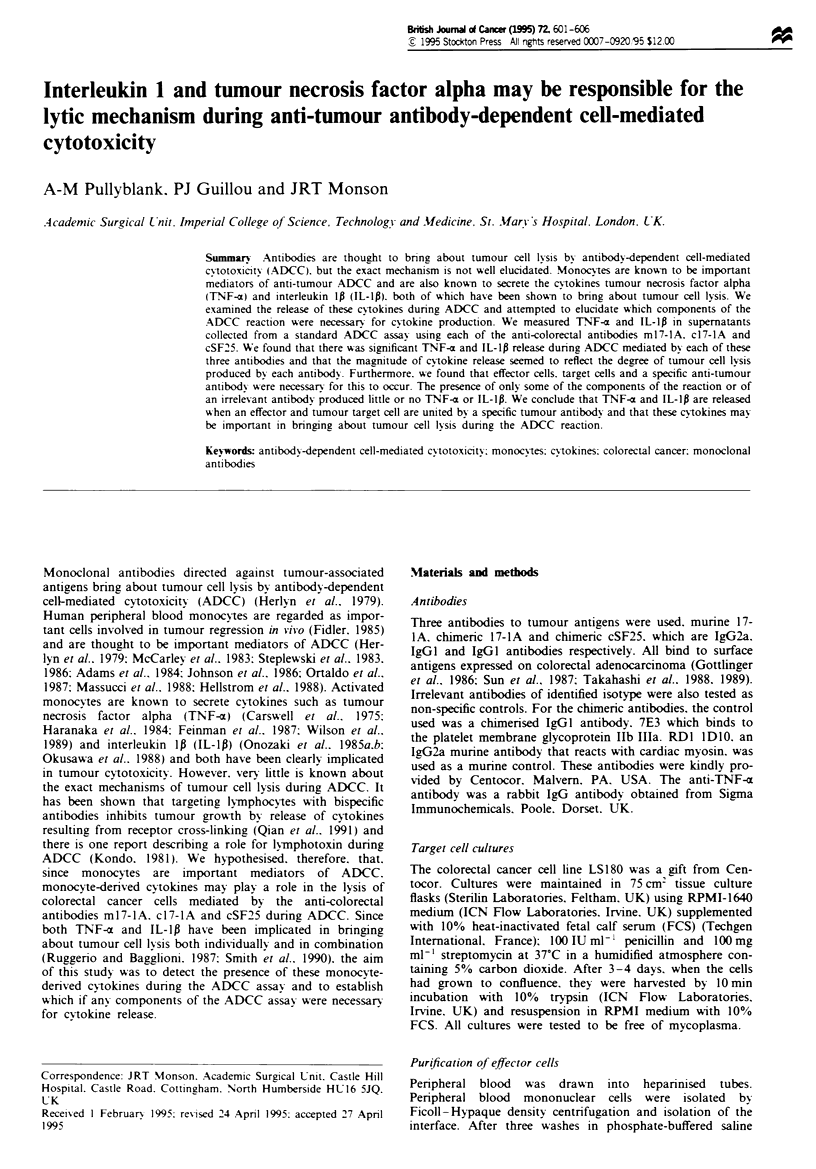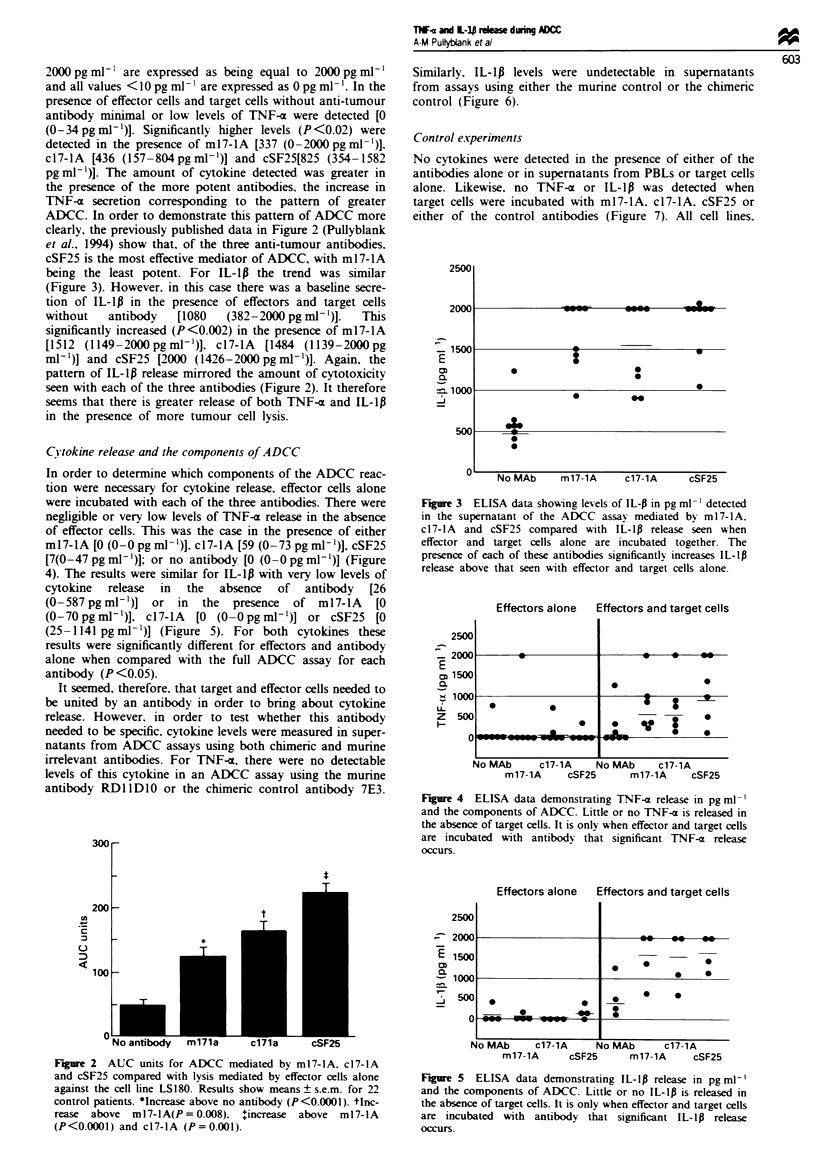Abstract
Antibodies are thought to bring about tumour cell lysis by antibody-dependent cell-mediated cytotoxicity (ADCC), but the exact mechanism is not well elucidated. Monocytes are known to be important mediators of anti-tumour ADCC and are also known to secrete the cytokines tumour necrosis factor alpha (TNF-alpha) and interleukin 1 beta (IL-1 beta), both of which have been shown to bring about tumour cell lysis. We examined the release of these cytokines during ADCC and attempted to elucidate which components of the ADCC reaction were necessary for cytokine production. We measured TNF-alpha and IL-1 beta in supernatants collected from a standard ADCC assay using each of the anti-colorectal antibodies m17-1A, c17-1A and cSF25. We found that there was significant TNF-alpha and IL-1 beta release during ADCC mediated by each of these three antibodies and that the magnitude of cytokine release seemed to reflect the degree of tumour cell lysis produced by each antibody. Furthermore, we found that effector cells, target cells and a specific anti-tumour antibody were necessary for this to occur. The presence of only some of the components of the reaction or of an irrelevant antibody produced little or no TNF-alpha or IL-1 beta. We conclude that TNF-alpha and IL-1 beta are released when an effector and tumour target cell are united by a specific tumour antibody and that these cytokines may be important in bringing about tumour cell lysis during the ADCC reaction.
Full text
PDF





Selected References
These references are in PubMed. This may not be the complete list of references from this article.
- Adams D. O., Hall T., Steplewski Z., Koprowski H. Tumors undergoing rejection induced by monoclonal antibodies of the IgG2a isotype contain increased numbers of macrophages activated for a distinctive form of antibody-dependent cytolysis. Proc Natl Acad Sci U S A. 1984 Jun;81(11):3506–3510. doi: 10.1073/pnas.81.11.3506. [DOI] [PMC free article] [PubMed] [Google Scholar]
- Bakouche O., Ichinose Y., Heicappell R., Fidler I. J., Lachman L. B. Plasma membrane-associated tumor necrosis factor. A non-integral membrane protein possibly bound to its own receptor. J Immunol. 1988 Feb 15;140(4):1142–1147. [PubMed] [Google Scholar]
- Carswell E. A., Old L. J., Kassel R. L., Green S., Fiore N., Williamson B. An endotoxin-induced serum factor that causes necrosis of tumors. Proc Natl Acad Sci U S A. 1975 Sep;72(9):3666–3670. doi: 10.1073/pnas.72.9.3666. [DOI] [PMC free article] [PubMed] [Google Scholar]
- Dye J. F., Somers S. S., Guillou P. J. Simplified quantitation of cytotoxicity by integration of specific lysis against effector cell concentration at a constant target cell concentration and measuring the area under the curve. J Immunol Methods. 1991 Apr 8;138(1):1–13. doi: 10.1016/0022-1759(91)90058-n. [DOI] [PubMed] [Google Scholar]
- Feinman R., Henriksen-DeStefano D., Tsujimoto M., Vilcek J. Tumor necrosis factor is an important mediator of tumor cell killing by human monocytes. J Immunol. 1987 Jan 15;138(2):635–640. [PubMed] [Google Scholar]
- Fidler I. J. Macrophages and metastasis--a biological approach to cancer therapy. Cancer Res. 1985 Oct;45(10):4714–4726. [PubMed] [Google Scholar]
- Graziano R. F., Erbe D. V., Fanger M. W. The mechanisms of antibody-dependent killing mediated by lymphoid and myeloid cells are distinct based on different divalent cation requirements. J Immunol. 1989 Dec 15;143(12):3894–3900. [PubMed] [Google Scholar]
- Göttlinger H. G., Funke I., Johnson J. P., Gokel J. M., Riethmüller G. The epithelial cell surface antigen 17-1A, a target for antibody-mediated tumor therapy: its biochemical nature, tissue distribution and recognition by different monoclonal antibodies. Int J Cancer. 1986 Jul 15;38(1):47–53. doi: 10.1002/ijc.2910380109. [DOI] [PubMed] [Google Scholar]
- Haranaka K., Satomi N., Sakurai A. Antitumor activity of murine tumor necrosis factor (TNF) against transplanted murine tumors and heterotransplanted human tumors in nude mice. Int J Cancer. 1984 Aug 15;34(2):263–267. doi: 10.1002/ijc.2910340219. [DOI] [PubMed] [Google Scholar]
- Hellström I., Garrigues U., Lavie E., Hellström K. E. Antibody-mediated killing of human tumor cells by attached effector cells. Cancer Res. 1988 Feb 1;48(3):624–627. [PubMed] [Google Scholar]
- Herlyn D., Herlyn M., Steplewski Z., Koprowski H. Monoclonal antibodies in cell-mediated cytotoxicity against human melanoma and colorectal carcinoma. Eur J Immunol. 1979 Aug;9(8):657–659. doi: 10.1002/eji.1830090817. [DOI] [PubMed] [Google Scholar]
- Johnson W. J., Steplewski Z., Matthews T. J., Hamilton T. A., Koprowski H., Adams D. O. Cytolytic interactions between murine macrophages, tumor cells, and monoclonal antibodies: characterization of lytic conditions and requirements for effector activation. J Immunol. 1986 Jun 15;136(12):4704–4713. [PubMed] [Google Scholar]
- Jänicke R., Männel D. N. Distinct tumor cell membrane constituents activate human monocytes for tumor necrosis factor synthesis. J Immunol. 1990 Feb 1;144(3):1144–1150. [PubMed] [Google Scholar]
- Kondo L. L., Rosenau W., Wara D. W. Role of lymphotoxin in antibody-dependent cell-mediated cytotoxicity (ADCC). J Immunol. 1981 Mar;126(3):1131–1133. [PubMed] [Google Scholar]
- Kondo L. L., Rosenau W., Wara D. W. Role of lymphotoxin in antibody-dependent cell-mediated cytotoxicity (ADCC). J Immunol. 1981 Mar;126(3):1131–1133. [PubMed] [Google Scholar]
- Kriegler M., Perez C., DeFay K., Albert I., Lu S. D. A novel form of TNF/cachectin is a cell surface cytotoxic transmembrane protein: ramifications for the complex physiology of TNF. Cell. 1988 Apr 8;53(1):45–53. doi: 10.1016/0092-8674(88)90486-2. [DOI] [PubMed] [Google Scholar]
- Kriegler M., Perez C., DeFay K., Albert I., Lu S. D. A novel form of TNF/cachectin is a cell surface cytotoxic transmembrane protein: ramifications for the complex physiology of TNF. Cell. 1988 Apr 8;53(1):45–53. doi: 10.1016/0092-8674(88)90486-2. [DOI] [PubMed] [Google Scholar]
- Luettig B., Decker T., Lohmann-Matthes M. L. Evidence for the existence of two forms of membrane tumor necrosis factor: an integral protein and a molecule attached to its receptor. J Immunol. 1989 Dec 15;143(12):4034–4038. [PubMed] [Google Scholar]
- Luettig B., Decker T., Lohmann-Matthes M. L. Evidence for the existence of two forms of membrane tumor necrosis factor: an integral protein and a molecule attached to its receptor. J Immunol. 1989 Dec 15;143(12):4034–4038. [PubMed] [Google Scholar]
- Masucci G., Lindemalm C., Frödin J. E., Hagström B., Mellstedt H. Effect of human blood mononuclear cell populations in antibody dependent cellular cytotoxicity (ADCC) using two murine (CO17-1A and Br55-2) and one chimeric (17-1A) monoclonal antibodies against a human colorectal carcinoma cell line (SW948). Hybridoma. 1988 Oct;7(5):429–440. doi: 10.1089/hyb.1988.7.429. [DOI] [PubMed] [Google Scholar]
- McCarley D. L., Shah V. O., Weiner R. S. Purified human monocyte subsets as effector cells in antibody-dependent cellular cytotoxicity (ADCC). J Immunol. 1983 Oct;131(4):1780–1783. [PubMed] [Google Scholar]
- McCarley D. L., Shah V. O., Weiner R. S. Purified human monocyte subsets as effector cells in antibody-dependent cellular cytotoxicity (ADCC). J Immunol. 1983 Oct;131(4):1780–1783. [PubMed] [Google Scholar]
- Nathan C., Brukner L., Kaplan G., Unkeless J., Cohn Z. Role of activated macrophages in antibody-dependent lysis of tumor cells. J Exp Med. 1980 Jul 1;152(1):183–197. doi: 10.1084/jem.152.1.183. [DOI] [PMC free article] [PubMed] [Google Scholar]
- Okusawa S., Gelfand J. A., Ikejima T., Connolly R. J., Dinarello C. A. Interleukin 1 induces a shock-like state in rabbits. Synergism with tumor necrosis factor and the effect of cyclooxygenase inhibition. J Clin Invest. 1988 Apr;81(4):1162–1172. doi: 10.1172/JCI113431. [DOI] [PMC free article] [PubMed] [Google Scholar]
- Onozaki K., Matsushima K., Aggarwal B. B., Oppenheim J. J. Human interleukin 1 is a cytocidal factor for several tumor cell lines. J Immunol. 1985 Dec;135(6):3962–3968. [PubMed] [Google Scholar]
- Onozaki K., Matsushima K., Kleinerman E. S., Saito T., Oppenheim J. J. Role of interleukin 1 in promoting human monocyte-mediated tumor cytotoxicity. J Immunol. 1985 Jul;135(1):314–320. [PubMed] [Google Scholar]
- Pullyblank A. M., Guillou P. J., Monson J. R. m17-1A-, c17-1A- and cSF25-mediated antibody-dependent cell-mediated cytotoxicity in patients with advanced cancer. Br J Cancer. 1994 Oct;70(4):753–758. doi: 10.1038/bjc.1994.390. [DOI] [PMC free article] [PubMed] [Google Scholar]
- Qian J. H., Titus J. A., Andrew S. M., Mezzanzanica D., Garrido M. A., Wunderlich J. R., Segal D. M. Human peripheral blood lymphocytes targeted with bispecific antibodies release cytokines that are essential for inhibiting tumor growth. J Immunol. 1991 May 1;146(9):3250–3256. [PubMed] [Google Scholar]
- Ruggiero V., Baglioni C. Synergistic anti-proliferative activity of interleukin 1 and tumor necrosis factor. J Immunol. 1987 Feb 1;138(3):661–663. [PubMed] [Google Scholar]
- Smith D. M., Lackides G. A., Epstein L. B. Coordinated induction of autocrine tumor necrosis factor and interleukin 1 in normal human monocytes and the implications for monocyte-mediated cytotoxicity. Cancer Res. 1990 Jun 1;50(11):3146–3153. [PubMed] [Google Scholar]
- Steplewski Z., Herlyn D., Lubeck M., Kimoto Y., Herlyn M., Koprowski H. Mechanisms of tumor growth inhibition. Hybridoma. 1986 Jul;5 (Suppl 1):S59–S64. [PubMed] [Google Scholar]
- Steplewski Z., Lubeck M. D., Koprowski H. Human macrophages armed with murine immunoglobulin G2a antibodies to tumors destroy human cancer cells. Science. 1983 Aug 26;221(4613):865–867. doi: 10.1126/science.6879183. [DOI] [PubMed] [Google Scholar]
- Sun L. K., Curtis P., Rakowicz-Szulczynska E., Ghrayeb J., Chang N., Morrison S. L., Koprowski H. Chimeric antibody with human constant regions and mouse variable regions directed against carcinoma-associated antigen 17-1A. Proc Natl Acad Sci U S A. 1987 Jan;84(1):214–218. doi: 10.1073/pnas.84.1.214. [DOI] [PMC free article] [PubMed] [Google Scholar]
- Takahashi H., Carlson R., Ozturk M., Sun S., Motte P., Strauss W., Isselbacher K. J., Wands J. R., Shouval D. Radioimmunolocation of hepatic and pulmonary metastasis of human colon adenocarcinoma. Gastroenterology. 1989 May;96(5 Pt 1):1317–1329. doi: 10.1016/s0016-5085(89)80019-8. [DOI] [PubMed] [Google Scholar]
- Takahashi H., Wilson B., Ozturk M., Motté P., Strauss W., Isselbacher K. J., Wands J. R. In vivo localization of human colon adenocarcinoma by monoclonal antibody binding to a highly expressed cell surface antigen. Cancer Res. 1988 Nov 15;48(22):6573–6579. [PubMed] [Google Scholar]
- Webb D. S., Shimizu Y., Van Seventer G. A., Shaw S., Gerrard T. L. LFA-3, CD44, and CD45: physiologic triggers of human monocyte TNF and IL-1 release. Science. 1990 Sep 14;249(4974):1295–1297. doi: 10.1126/science.1697984. [DOI] [PubMed] [Google Scholar]
- Wilson K. M., Siegal G., Lord E. M. Tumor necrosis factor-mediated cytotoxicity by tumor-associated macrophages. Cell Immunol. 1989 Oct 1;123(1):158–165. doi: 10.1016/0008-8749(89)90276-1. [DOI] [PubMed] [Google Scholar]


